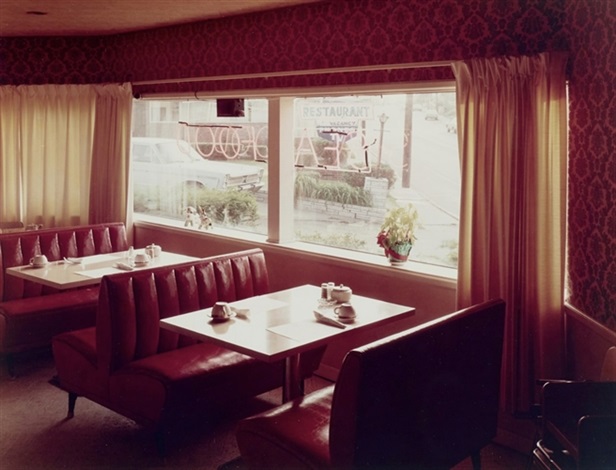Stephen Shore, an American photographer born in 1947, has carved a significant place in the art world by turning the ordinary into art. His work has influenced generations of photographers and has become synonymous with the exploration of everyday life. One of his seminal works, Town and Country Restaurant, East 7th Street, Parkersburg, West Virginia, May 16, 1974, is a chromogenic print that exemplifies his unique approach to capturing the mundane with extraordinary detail and meaning. This single image represents Shore’s broader philosophy of photography and his role as a pioneer of color photography as an artistic medium.
Stephen Shore’s Early Life and Rise to Fame
Stephen Shore was born in New York City in 1947. A precocious child, he displayed an early interest in photography, receiving his first darkroom kit at the age of six. By the time he was 14, he was introduced to Andy Warhol and became a frequent visitor to Warhol’s Factory, where he documented the vibrant and avant-garde culture of the 1960s.
Shore’s early black-and-white photography demonstrated a keen eye for composition and detail, but it was his transition to color photography that set him apart. In the 1970s, he embarked on a series of road trips across America, documenting the landscapes, diners, motels, and everyday scenes that defined the country. His groundbreaking use of color and large-format cameras elevated scenes of ordinary life into works of art.
The Context of Town and Country Restaurant
Taken on May 16, 1974, Town and Country Restaurant, East 7th Street, Parkersburg, West Virginia is one of the many images that Shore captured during his cross-country travels. It was created as part of his celebrated series Uncommon Places, which documented the American vernacular landscape with a meticulous focus on color, light, and composition.
This photograph is a chromogenic print, a process that became popular in the mid-20th century and allowed for rich, vibrant colors. Shore’s decision to embrace color photography during a time when it was often dismissed as a commercial medium rather than fine art demonstrated his innovative vision.
The Town and Country Restaurant photograph captures a scene of quiet normalcy—a diner in a small West Virginia town. The image’s details—such as the neon sign, the architecture of the building, and the interplay of light and background—reveal the aesthetic beauty of an otherwise unremarkable setting. The photograph is a snapshot of a specific time and place in American history, immortalizing a scene that might otherwise have been forgotten.
A Study in Composition and Color
One of the most striking aspects of Shore’s work is his meticulous attention to composition. In Town and Country Restaurant, the frame is carefully balanced, with each element contributing to the overall visual harmony. The restaurant’s signage, the surrounding architecture, and the sky all work together to create a sense of order and structure.
Shore’s use of color is equally noteworthy. The chromogenic process allows for a vivid palette that enhances the image’s realism. The soft blues of the sky, the muted tones of the building, and the glowing neon sign combine to create a rich visual experience. These colors not only document the physical appearance of the scene but also evoke the atmosphere and mood of small-town America in the 1970s.
The Significance of Everyday Life
Stephen Shore’s work challenges traditional notions of what is considered “artworthy.” By focusing on the mundane, he elevates the ordinary to the extraordinary. Town and Country Restaurant is a perfect example of this philosophy. A simple roadside diner, a ubiquitous part of the American landscape, becomes a subject worthy of artistic exploration.
This focus on the everyday is part of a larger movement in 20th-century art, where artists sought to blur the boundaries between high art and popular culture. Shore’s photographs align with the ethos of artists like Andy Warhol, who celebrated consumerism and mass culture, as well as photographers like Walker Evans, who documented the everyday struggles and triumphs of Americans during the Great Depression.
Influence on Contemporary Photography
Stephen Shore’s Uncommon Places series, which includes Town and Country Restaurant, has had a profound impact on the world of photography. His use of color, large-format cameras, and everyday subject matter paved the way for future generations of photographers to explore similar themes. Artists like Alec Soth, Joel Meyerowitz, and William Eggleston have cited Shore as a major influence on their work.
Shore’s emphasis on the documentary aspect of photography—capturing the truth of a moment, unembellished and unmanipulated—resonates with contemporary photographers who seek to document the complexities of modern life. His work remains relevant in an era where photography is ubiquitous, reminding viewers of the power of a single image to tell a story.
Cultural and Historical Significance
The photograph Town and Country Restaurant is more than just a visually pleasing image; it is a cultural and historical artifact. Taken during the mid-1970s, it reflects a specific moment in American history. The architecture of the restaurant, the design of its signage, and even the cars parked nearby provide clues about the era’s cultural and economic conditions.
During the 1970s, America was undergoing significant social and economic changes. The rise of car culture, the development of the interstate highway system, and the increasing prominence of fast food and roadside diners were all shaping the nation’s landscape. Shore’s photograph captures these elements with a quiet precision, offering a window into the past.
The Art of Observation
One of Stephen Shore’s greatest talents as a photographer is his ability to observe and capture the subtleties of the world around him. His images are often deceptively simple, inviting viewers to look closer and appreciate the details that might otherwise go unnoticed.
In Town and Country Restaurant, for example, the interplay of natural and artificial light creates a sense of depth and texture. The way the backdrop falls across the building, the reflection of the neon sign in the windows, and the slightly overcast sky all contribute to the photograph’s mood. These details transform a simple scene into a rich, layered composition.
Legacy and Ongoing Relevance
Stephen Shore’s work, including Town and Country Restaurant, continues to be celebrated and studied in the art world. His photographs are featured in major museum collections, including the Museum of Modern Art in New York, the Getty Museum in Los Angeles, and the National Gallery of Art in Washington, D.C. Shore has also published numerous books, such as Uncommon Places and American Surfaces, which have become essential reading for photography enthusiasts and students.
In addition to his artistic contributions, Shore has been an influential educator, serving as the director of the photography program at Bard College in New York. Through his teaching, he has inspired countless young photographers to find beauty in the everyday and to approach their work with thoughtfulness and precision.
Stephen Shore’s Town and Country Restaurant, East 7th Street, Parkersburg, West Virginia, May 16, 1974, is a masterful example of his ability to find beauty and significance in the ordinary. Through his innovative use of color, composition, and subject matter, Shore challenges viewers to see the world in new ways. The photograph is not just a documentation of a moment in time but a testament to the power of observation and the art of photography.
As Shore himself once said, “To see something spectacular and recognize it as a photograph is really a different way of seeing.” This philosophy is at the heart of his work, reminding us that art can be found all around us if we take the time to look.
No comments yet.








